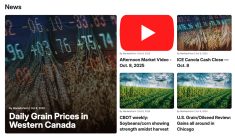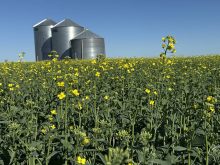Fed cattle demand good
Fed cattle prices rose last week thanks to strong demand.
Prices Aug. 19 were steers $87.20-$90.50 per hundredweight, flat rail $147.25-$150.80, and heifers $87.50-$90.50, flat rail $146.
Carcass weights are still a concern for some packers, but wholesale beef prices held steady. Movement declines are expected as Labor Day approaches.
The Calgary wholesale price was expected to climb $1-$2 per cwt. to a range of $148-$155. Expect prices to hold their course.
Cow prices were under pressure last week. Bottom end prices on D1,2 cows started at $47. By the end of the week, it took a really good D1,2 to get $58. The market will struggle to hold steady.
Read Also

Huge Black Sea flax crop to provide stiff competition
Russia and Kazakhstan harvested huge flax crops and will be providing stiff competition in China and the EU.
It was an excellent week for those with feeders to sell.
Heavyweight yearling steers sold well, with 850-lb. animals averaging $111 per cwt., and sales up to $119 on the 800-lb. animals.
Volumes climbed, with just over 41,000 head reported sold, both live and contract sales included. That’s up 53 percent from the previous week.
Outlook: With fed cattle topping $90 per cwt. on a few sales at the end of the week, feeders and yearlings should again fetch strong prices this week
In stock cow trade, bred cows ranged from $600-$1,000 on few sales. No bred heifers were quoted. Cow-calf pairs sold from $750-$1,525. The outlook is steady.
Hog prices stagnate
With ample supplies of hogs, lower wholesale pork prices and too much pork in storage, there was no incentive for U.S. packers to increase hog prices last week.
Iowa-Southern Minnesota hog prices (plant top, 51-52 percent lean, live equivalent) declined to $41.50 (U.S.) per cwt. early, rising slightly to $42.25 per cwt. at midweek.
Hog futures prices also declined as traders expected the results of Friday’s USDA cold storage report to show record pork stocks at the end of July.
Prices could continue their seasonal decline into the fall because U.S. hog market weights are still above last year, and hog slaughter could reach close to the two million head level by the end of September.
To minimize the impact of overweight hogs on prices, producers should be marketing hogs at optimum weights. Average Manitoba Index 100 hog prices declined by about $3 per100 kilograms to an estimated $142 per ckg for the week. Local prices did get a slight boost from the lower-valued Canadian dollar Aug. 19.
















